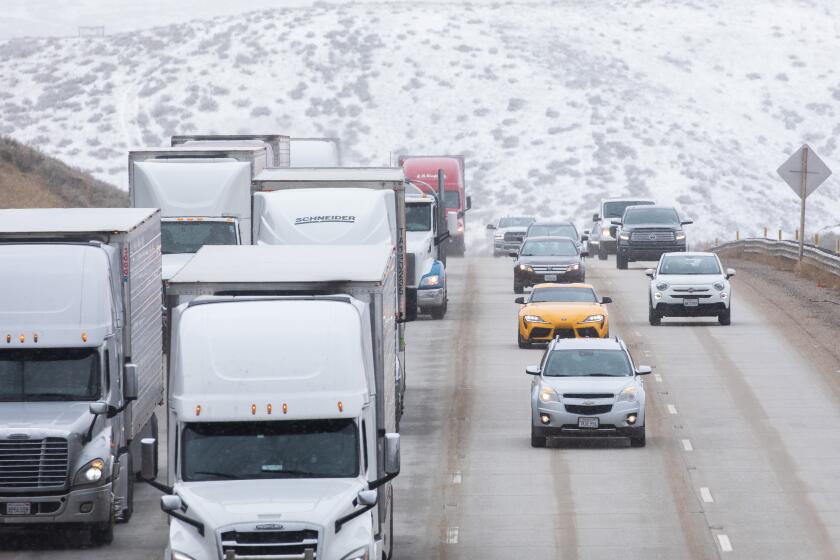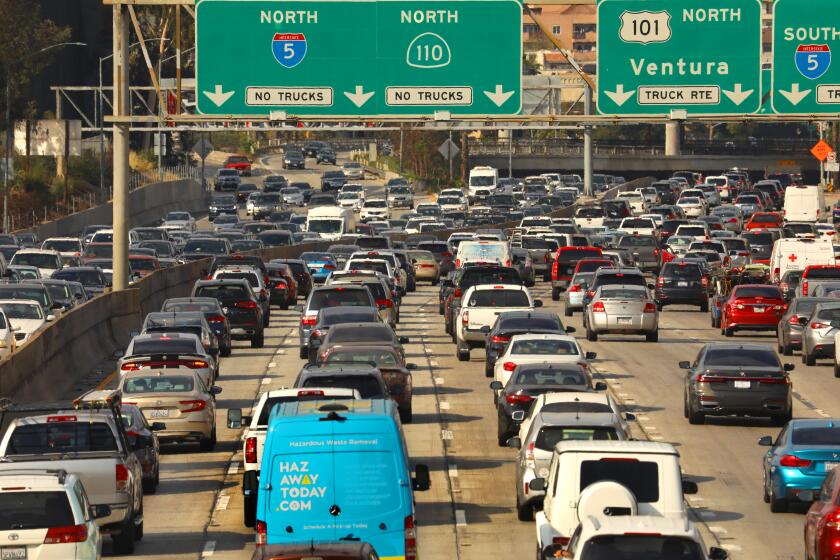California auto insurance rates are skyrocketing: Here’s why and how to save

- Share via
California is as car crazy as ever, with insurance rates increasing to match.
Data analyzed by the insurance comparison website Insurify showed the average annual cost of full coverage in California was $2,417 as of June, up from $1,666 the year before.
And premiums are projected to continue rising, to an estimated $2,681 for full coverage by the end of the year, the report found.
Full-coverage policies include comprehensive and collision coverage, as well as liability coverage, according to Insurify.
“The increases that have occurred have been largely driven by a continuation of people driving more, resulting in an increasing frequency of claims and inflationary pressures related to vehicle prices and repairs,” said Gabriel Sanchez, spokesperson for the state Department of Insurance.
California car insurance regulators approved some big rate increases in the last six months after a long COVID break. And more are in the pipeline.
While many insurers have applied and were approved for rate increases by the department, others — frustrated with state regulations — have either limited the number of new policies in California or stopped offering them altogether.
The cost of auto claims has soared across the United States since the start of the COVID-19 pandemic, according to the Insurance Information Institute.
But the pandemic isn’t solely to blame. Other factors include changes in driving habits, past supply chain issues and how cars are made, said Michael Giusti, an analyst at InsuranceQuotes.com.
After pandemic-era stay-at-home orders were lifted, Giusti said, people hit the road in droves — and continue to drive more now than before.
The cars people are driving are also a factor in increased coverage costs. New cars are more expensive, which means there’s a higher cost to insure them, he said.
Allstate, one of the largest insurers in the country, has resumed writing new policies through its website. But the costs are going up.
The technological bells and whistles packed into newer cars can drive up the cost of a potential claim. For example, Giusti said if he backed into a pole with his first car — a 1977 Dodge Aspen — the pole would have sustained more damage than the steel bumper.
“Today, if I backed into it, not only is it going to crack my plastic bumper but it’s going to kill the sensor,” he said.
In the claim, he would have to report the bumper replacement, rewiring and recalibration of the sensor and buffing the area. What may have once been a simple fender bender has “turned into a major claim,” he said.
Another factor compounding insurance rates is the cost of medical bills in the event of an accident. Hospital service costs rose 6.7% nationally between January 2023 and January 2024, the U.S. Bureau of Labor Statistics reported.
But despite the head winds, there are still ways to save money on your premium as you navigate the concrete jungle as safely as possible:
Insurers say state regulators are responsible for the difficulties that some drivers are having lining up new policies. Consumer advocates blame greed.
Shop around
Whether you have an insurance provider or not, Giusti said you should always shop around. It’s a thing of the past to stick with an insurance provider just because you’ve been a customer for a long time — it doesn’t guarantee any savings.
“I’m not saying jump ship willy-nilly, but you do want to make sure that you’re getting the competitive rate,” he said.
Sticker price only goes so far, though. The Insurance Information Institute also advises that you ask friends and relatives for their recommendations.
Maximize your credit
After making some calls to agents or company representatives, you might find one insurer will offer you a drastically different price than another based on your credit score.
That’s why it’s important to maintain your credit score by paying your bills on time, not obtaining more credit than you need and keeping your credit balances as low as possible, according to the Insurance Information Institute.
Relentlessly rising auto insurance rates are squeezing car owners and stoking inflation. Auto insurance rates rose 2.6% in March and are up 22% from a year ago.
Reconsidering coverage
The age of your car also determines what kind of policy you’re offered and how much it’ll cost, Giusti said.
If you have a car that’s at least 10 years old, he advises thinking about whether you need a collision policy or a comprehensive policy.
“Reducing your coverage if your car is paid off and you don’t need quite as much is a good way to save some money, especially if the value of the car is kind of creeping down,” Giusti said.
Deducing deductibles
Ask for higher deductibles before your insurance policy kicks in, the institute recommends. By requesting a higher deductible — the amount you must pay before your policy starts paying covered expenses — you can substantially lower your costs. For example, increasing your deductible from $200 to $500 could reduce your collision and comprehensive coverage cost by 15% to 30%. Going to a $1,000 deductible could save you 40% or more.
Bundling auto insurance with other policies, including homeowners insurance, may also reduce your premium cost.
Department of Insurance says auto insurers are creating barriers for new and renewing members, possibly violating state law.
Inquire about discounts
Giusti said you can also ask your insurance provider for discounts.
The institute provided a list of some common discounts, though their availability depends on the insurer and where you live:
- Anti-theft devices
- Auto and homeowners coverage with the same company
- College students away from home
- Defensive driving courses
- Drivers ed courses
- Good credit record
- Low annual mileage
- Longtime customer
- More than one car
- No accidents in three years
- No moving violations in three years
- Student drivers with good grades
More to Read
Sign up for Essential California
The most important California stories and recommendations in your inbox every morning.
You may occasionally receive promotional content from the Los Angeles Times.
















